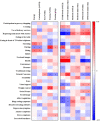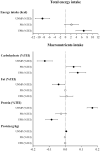Poor Eating Habits and Selected Determinants of Food Choice Were Associated With Ultraprocessed Food Consumption in Brazilian Women During the COVID-19 Pandemic
- PMID: 34055859
- PMCID: PMC8155283
- DOI: 10.3389/fnut.2021.672372
Poor Eating Habits and Selected Determinants of Food Choice Were Associated With Ultraprocessed Food Consumption in Brazilian Women During the COVID-19 Pandemic
Abstract
Background: The aim of this study was to investigate possible associations between food consumption and eating habits and food choice determinants in women during COVID-19 pandemic. Methods: This is a cross-sectional survey conducted in Brazil between June and September, 2020, during which time social distancing measures were in place. Results: Participants (n = 629) were aged 34.0 years and mostly within normal weight according to BMI (60.4%). "Snacking" and "liking" associated with increased energy (β = 164.27 and β = 110.24) and carbohydrate intake (β = 1.97 and β = 1.80), and with reduced protein intake (β = -1.54 and β = -1.18). In contrast, "dieting" and "weight control" associated with reduced energy (β = -162.57 and β = -111.49) and carbohydrate intake (β = -2.78 and β = -2.07), and with increased protein intake (β = 3.78 and β = 1.65). "Dieting" (β = 7.27), "need and hunger" (β = 3.34), and "health" (β = 4.94) associated with an increased consumption of unprocessed and minimally processed foods, whereas "replacing main meals with snacks" (β = -8.98), "snacking" (β = -6.92) and binge eating symptoms (β = -0.34) associated with reduced consumption of foods within this processing level. In contrast, "use of delivery services" (β = 3.39), "replacing main meals with snacks" (β = 5.49), "visual appeal" (β = 2.17), "social norms" (β = 2.19) and "affect regulation" (β = 2.01) associated with increased ultraprocessed food consumption. Overall, associations were more frequent and pronounced when analyzing food consumption by processing level rather than by macronutrient intake. Conclusion: Some eating habits and food choice determinants ("snacking," "replacing meals with snacks," "use of delivery services") observed during the COVID-19 pandemic were associated with an unhealthy diet (high energy and carbohydrate consumption, increased ultraprocessed food consumption and reduced unprocessed/minimally processed foods consumption) in Brazilian women.
Keywords: SARS-CoV-2; eating behavior; food processing level; macronutrient intake; quarantine.
Copyright © 2021 Smaira, Mazzolani, Esteves, André, Amarante, Castanho, Campos, Benatti, Pinto, Roschel, Gualano and Nicoletti.
Conflict of interest statement
The authors declare that the research was conducted in the absence of any commercial or financial relationships that could be construed as a potential conflict of interest.
Figures


Similar articles
-
Influence of Body Mass Index on Eating Habits and Food Choice Determinants Among Brazilian Women During the COVID-19 Pandemic.Front Nutr. 2021 Jul 12;8:664240. doi: 10.3389/fnut.2021.664240. eCollection 2021. Front Nutr. 2021. PMID: 34322509 Free PMC article.
-
Protein and Amino Acid Adequacy and Food Consumption by Processing Level in Vegans in Brazil.JAMA Netw Open. 2024 Jun 3;7(6):e2418226. doi: 10.1001/jamanetworkopen.2024.18226. JAMA Netw Open. 2024. PMID: 38913373 Free PMC article.
-
Did social isolation during the SARS-CoV-2 epidemic have an impact on the lifestyles of citizens?Epidemiol Prev. 2020 Sep-Dec;44(5-6 Suppl 2):353-362. doi: 10.19191/EP20.5-6.S2.137. Epidemiol Prev. 2020. PMID: 33412829 English.
-
Meals and snacking, diet quality and energy balance.Physiol Behav. 2014 Jul;134:38-43. doi: 10.1016/j.physbeh.2014.03.010. Epub 2014 Mar 19. Physiol Behav. 2014. PMID: 24657181 Review.
-
The impact of COVID-19 lockdown on snacking habits, fast-food and alcohol consumption: A systematic review of the evidence.Clin Nutr. 2022 Dec;41(12):3038-3045. doi: 10.1016/j.clnu.2021.04.020. Epub 2021 Apr 17. Clin Nutr. 2022. PMID: 34049747 Free PMC article.
Cited by
-
Food consumption based on processing level (according to Nova system) during the COVID-19 pandemic among adolescents with immunocompromised conditions: a case-control study.Front Nutr. 2023 May 16;10:1141845. doi: 10.3389/fnut.2023.1141845. eCollection 2023. Front Nutr. 2023. PMID: 37260519 Free PMC article.
-
Impact of Final Phase Social Isolation and the COVID-19 Pandemic on Eating Behavior, Sleep Quality, and Anxiety Level.Nutrients. 2023 Apr 29;15(9):2148. doi: 10.3390/nu15092148. Nutrients. 2023. PMID: 37432299 Free PMC article.
-
COVID-19, Food Insecurity and Malnutrition: A Multiple Burden for Brazil.Front Nutr. 2021 Dec 15;8:751715. doi: 10.3389/fnut.2021.751715. eCollection 2021. Front Nutr. 2021. PMID: 34977114 Free PMC article. No abstract available.
-
Effects of physical distancing by COVID-19 pandemic on diet quality, neurological and immunological markers, and fecal microbiota of Brazilian older women.Front Nutr. 2022 Sep 14;9:972100. doi: 10.3389/fnut.2022.972100. eCollection 2022. Front Nutr. 2022. PMID: 36211483 Free PMC article.
-
Changes in Ultra-Processed Food Consumption and Lifestyle Behaviors Following COVID-19 Shelter-in-Place: A Retrospective Study.Foods. 2021 Oct 23;10(11):2553. doi: 10.3390/foods10112553. Foods. 2021. PMID: 34828834 Free PMC article.
References
LinkOut - more resources
Full Text Sources
Other Literature Sources
Miscellaneous

